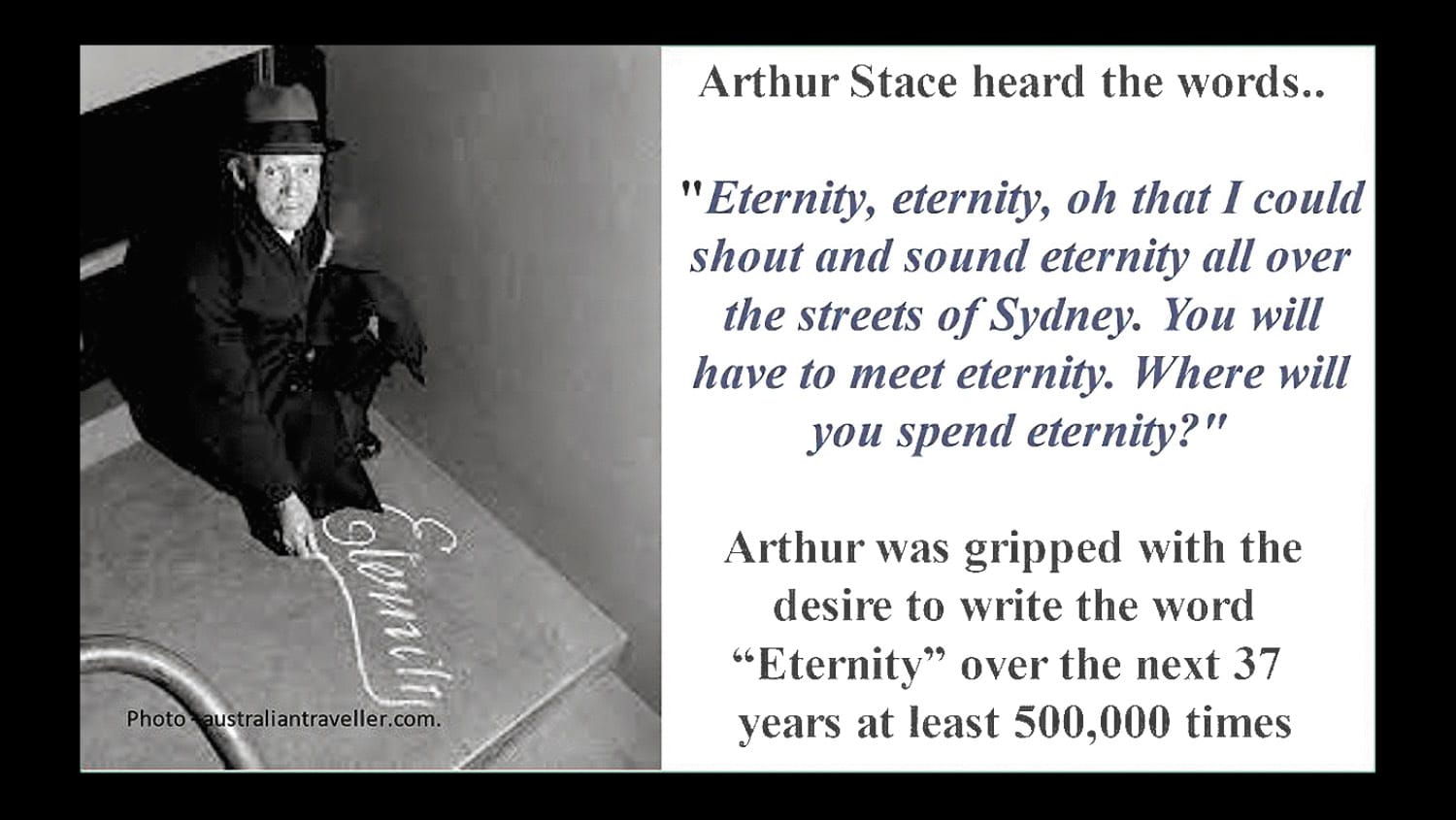Mr Eternity
I remember the time our ferry approached the iconic Sydney Harbour Bridge. It was quite a sight. The Harbour Bridge is the largest steel arch bridge on earth, stands 134m tall and was completed in 1932 in the depths of the Great Depression. The...

I remember the time our ferry approached the iconic Sydney Harbour Bridge. It was quite a sight. The Harbour Bridge is the largest steel arch bridge on earth, stands 134m tall and was completed in 1932 in the depths of the Great Depression.
The Harbour Bridge was the centrepiece of Australia’s New Year’s Eve millennium fireworks display, which was broadcast around the world ushering in the new millennium 22 years ago. On that bridge was emblazoned the word ‘Eternity’ written in copperplate script. Organisers said that it was a tribute to a man who died in 1967 leaving an extraordinary legacy. Arthur Stace wrote a one-word sermon ‘Eternity’ all over Sydney and beyond in chalk or crayon an estimated half a million times over a period of 37 years.
Who was Arthur Stace? Arthur Stace was born in a brothel in Balmain, Sydney, back in 1885. His father, mother, two sisters and two brothers were alcoholics. He grew up in abject poverty and by the age of five, he was stealing bread and milk just to survive. At 15, he found himself in gaol for the first of many occasions. Arthur served in France as a stretcher bearer in the First World War. He was injured and repatriated back to Australia. Most of the 1920s passed by in an alcoholic haze.
During the Great Depression of the early 1930s, things had become even more desperate for Arthur and thousands of others. Arthur heard about a local church which was offering free hot drinks and rock cake with the proviso that the recipients of the meal first listen to a message from the church minister, Robert Hammond. On August 6, 1930, Arthur wandered into this church and that night, he heard these words, “If any of you men are sick of the lives you are living, there is One who loves you, who will set you free, and His Name is Jesus.” (‘Mr Eternity’, authors Roy Williams and Elizabeth Myers.) Arthur was desperate. He was ashamed of his dark past and his dire present. He knew he needed the power to change.
During and after the meeting, Arthur came under ‘strong conviction of sin’. After drinking his tea and eating his rock cake, he left the hall alone and walked into Victoria Park and there, under a large Moreton Bay fig tree in the dark and out of sight, he knelt and wept. Then he cried out in a simple prayer, “God be merciful to me, a sinner!” Words which he had heard from Robert Hammond. Peace came to his troubled soul. This commitment to follow Jesus became the turning point in Arthur’s life and his alcoholism was left behind.
Around two years later, Arthur attended another church service. This time, Rev. John Ridley was the preacher, and the subject of his message was ‘Eternity’. John proclaimed, “Eternity, eternity, oh that I could shout and sound eternity all over the streets of Sydney. You will have to meet eternity. Where will you spend eternity?” Arthur again heard the still small voice of God speaking to his mind. He was gripped with the desire to write the word ‘Eternity’. He reached into his coat pocket and drew out a piece of chalk and wrote the word ‘Eternity’ in a beautiful copperplate script. From then on, Arthur often rose at 4am and walked or took a train to parts of Sydney and beyond and wrote the word ‘Eternity’ for one or two hours most days.
Many thousands of people were impacted by this one-word sermon, stimulating thoughts about “Where will I spend eternity?” This question remains true for each of us today. The Bible says there is a heaven and there is a hell and Jesus died a horrible death to save us from a horrible destination. May we too hear the still small voice of God and in confession of sin and repentance, receive Jesus as Saviour and Lord as Arthur did all those years ago. Our response to this question affects our eternity. Have a great day.





